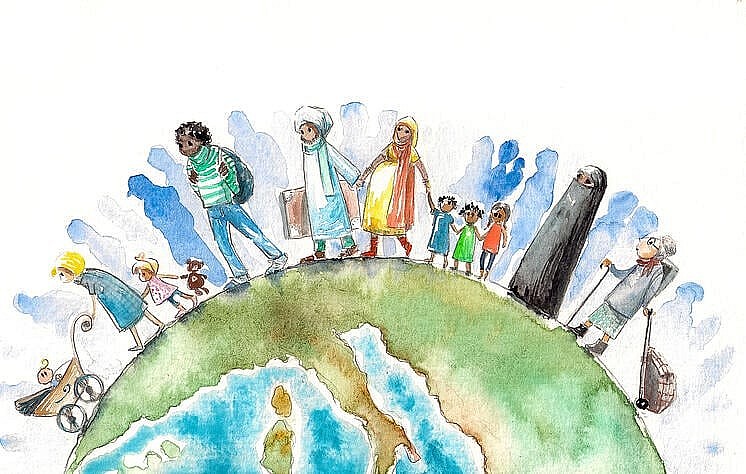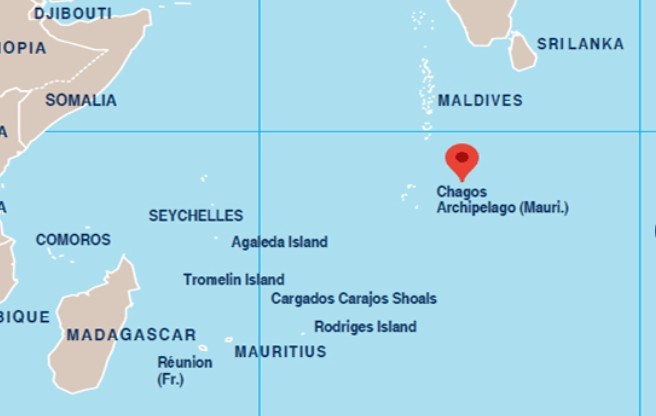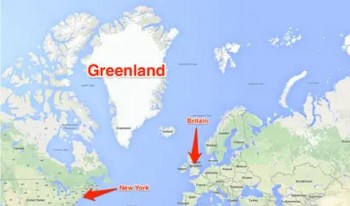Top 15 Countries with the Highest Immigration Population
 |
| Top 15 Most Popular Countries For Immigration By Number Of Immigrants |
| Table of Contents |
Legal immigrants are required to pay substantial fees and undergo extensive authorization processes in order to establish residency in a new country. However, in the nations that receive the greatest number of immigrants, unauthorized immigration remains a contentious issue. The United States faces a substantial challenge in this regard, as recent estimates place the number of unauthorized immigrants at approximately eleven million.
Similarly, the European Union encountered difficulties when irregular arrivals reached their highest point during the Syrian refugee and migration crisis of 2015, when more than one million migrants entered the continent. The manner in which the situation was managed brought to light divisions that existed within the EU. Several member states, including Sweden and Germany, initially exhibited a favourable stance towards the substantial influx of refugees. Conversely, Hungary and Poland vehemently opposed compulsory quotas for the resettlement of refugees.
What Facts Impact Immigration?
1. Economic Opportunities: Nations that provide favorable business environments, lucrative employment opportunities, and higher wages frequently entice immigrants, enabling them to enhance their quality of life. This factor exerts a substantial influence on immigration patterns, given that nations hosting the greatest number of immigrants generally offer ample economic prospects.
2. Foreign Immigrant Attractiveness: Nations characterized by political stability, minimal corruption, and a steadfast adherence to human rights are generally more attractive to prospective migrants in search of security, protection, and an improved future for their families.
3. Education: Immigrants' access to reputable academic institutions and high-quality education is crucial, as it empowers them to gain knowledge and develop skills that improve their future employment opportunities and overall prosperity.
4. Quality of Life: Nations that provide a high standard of living—including accessible healthcare, hygienic surroundings, social welfare systems, and leisure activities—attract immigrants by enhancing their general welfare.
5. Sociocultural Implications: Immigration contributes to the fabric of society in host nations by introducing diversity. Multiculturalism fosters a more inclusive society by encouraging understanding, tolerance, and the exchange of ideas. Nations with the highest influx of immigrants frequently celebrate and embrace this diversity, resulting in communities that are culturally vibrant and enriched.
| Numerous migrants continue to remit funds to their country of origin. Over the past few years, the number of migrant workers in high-income countries has decreased marginally, from 112.3 million to 111.2 million. Conversely, the greatest growth was observed in upper middle-income countries (from 17.5 million to 30.5 million). The United States continued to be the leading sender of remittances. The expenditure of foreign workers in the United States to foreign countries amounted to $68.0 billion. Saudi Arabia ($36.1 billion) and the United Arab Emirates ($44.4 billion) are two additional leading remittance-sending nations. The top three recipients of remittances received approximately 26% of the funds: India ($78.6 billion), China ($67.4 billion), and Mexico ($35.7 billion). |
Immigration Policies Of Most Popular Countries For Immigration
The United States of America: Family-sponsored immigrant visas (B-1/B-2), temporary work visas (H-1B), and visitor visas (B-1/B-2) are among the numerous visa programs offered by the United States. Citizenship in the United States is generally acquired through lawful permanent residency (green card) and compliance with language and residency requirements. In recent years, the United States has implemented various policy modifications, such as revisions to travel bans, more stringent enforcement strategies, and suggested reforms to the immigration system.
Germany: Visas are available for asylum seekers, work, study, and family reunification. Acquiring German citizenship necessitates fulfillment of residence and language prerequisites, successful completion of an integration course, and public exhibition of allegiance to German values. In an effort to attract skilled labor, Germany has enacted policies such as the Skilled Immigration Act and measures to streamline asylum procedures and integration initiatives.
Saudi Arabia has distinct visa categories for religious pilgrimage (Hajj and Umrah), employment, and residency. Saudi Arabian citizenship is typically acquired through matrimony to a Saudi national or through birth to Saudi parents, as opposed to immigration. The introduction of the "green card" residency program for skilled expatriates and reforms to the sponsorship (kafala) system are recent policy developments in Saudi Arabia.
Russia provides a diverse range of visa categories, encompassing work visas, study visas, and tourist visas. With the exception of a few nations, obtaining Russian citizenship generally entails fulfilling residency prerequisites, passing language and history examinations, and renunciating prior citizenship. The implementation of electronic visas for particular regions and the expansion of the streamlined naturalization procedure for Russian-speaking citizens are recent policy developments in Russia.
United Kingdom: Work visas (Tier 2), student visas (Tier 4), family visas (spouse/partner visas), and visitor visas are among the numerous visa programs offered by the United Kingdom. In order to obtain British citizenship, applicants generally must possess settled status or indefinite leave to remain (ILR), satisfy residency prerequisites, pass language and life in the UK assessments, and exhibit exemplary moral character. Recent immigration system modifications in the United Kingdom include the termination of free movement for EU citizens, the implementation of a points-based system in lieu of the previous one, and the prioritization of skills and qualifications over qualifications and skills post-Brexit.
Top 15 Most Popular Countries For Immigration By Number Of Immigrants
 |
1. USA
Number of immigrants: 51 million
It is the foremost choice and most popular destination for numerous immigrants worldwide, which contributes to its ranking as the first immigration country globally. Despite being regarded as the most despised nation globally, the United States remains the foremost immigration destination on account of its many appealing attractions.
With an estimated GDP (PPP) per capita of $53,001, the United States is the third most populous country in the world, with a total population of approximately 318.97 million people. Based on estimates, the number of immigrants residing in the United States is 51 million, the highest figure globally at 19.8% of the total number of immigrants and 14.3% of the national population.
Read More: 4 Crucial Tips for Immigrants Buying Homes in the United States
2. Germany
Number of immigrants: 13 million
Due to the strength of its economy, Germany is among the most sought-after countries for immigration. Germany's immigration patterns have been impacted by several factors, including its advanced infrastructure, prestigious educational system, and the Eurozone's financial difficulties. Nevertheless, Germany also recruits highly skilled laborers for permanent residence and employment.
3. Saudi Arabia
Number of immigrants: 13 million
Saudi Arabia, boasting an approximate immigrant population of 13,454,842, is positioned as the third most populous nation in terms of immigration. A significant proportion of the populace of Saudi Arabia consists of immigrants, comprising approximately 38% of the overall populace. Foreign labor has been drawn to the nation, especially to sectors including construction, healthcare, and oil-related industries.
4. Russia
Number of immigrants: 12 million
Russia is classified as the most expansive nation on the planet. Its population of approximately 143.8 million places it among the most populous nations globally; however, its GDP (PPP) per capita is a relatively modest $24,764. An estimated 12 million individuals have immigrated to Russia, accounting for 7.7% of the country's total population and 4.8% of the global immigrant population. Attractive to immigrants to Russia are the country's robust economy, high-quality education, health care, and amenities. The Russian government encourages immigrants to travel to and reside in the country in an effort to increase its population.
5. UK
Number of immigrants: 10 mil
From 2000 to 2015, the migrant population of the United Kingdom of Great Britain and Northern Ireland increased dramatically, nearly doubling from 4.7 million to 8.5 million. As a result of the substantial influx of East European migrants that followed the 2004 EU enlargement, the increase has occurred. Pakistan, India, and Poland are the top three countries of origin for foreign-born residents of the United Kingdom.
6. United Arab Emirates
Number of immigrants: 7.8 million
The United Arab Emirates' reputation as one of the wealthiest nations globally serves as the primary incentive for the country's high immigrant influx. It is home to approximately 9.2 million individuals and has a per capita gross domestic product (GDP) of $30,984. Approximately 7.8 million individuals are immigrants in the United Arab Emirates; this accounts for 3.4% of the global total of immigrants. 83.7 percent of the national population resides in the United Arab Emirates; these individuals are predominantly foreigners or immigrants. The United Arab Emirates attracts immigrants due to its robust and stable economy, high incomes, and high standard of living, as well as its abundance of amenities. The nation is subject to criticism due to its treatment of laborers who are required to work extended hours without any respite.
READ MORE: How To Move to Canada from USA?
7. France
Number of immigrants: 7.4 million
Who would not desire to reside in this idyllic nation? The largest nation in Western Europe is France. The estimated total population of the region is 66.6 million individuals, while its per capita gross domestic product (GDP) is approximately $36,537. Approximately 7.4 million individuals have immigrated to France, accounting for 11.6% of the country's total population and 3.2% of the global immigrant population. Numerous elements contribute to France's appeal as a destination for immigrants, encompassing exceptional healthcare, remarkable educational institutions, a high standard of living, and unrestricted movement for EU citizens.
8. Canada
Number of immigrants: 7.3 million
Canada ranks as the second most expansive nation globally in terms of land area. It has an estimated population of 35.5 million individuals and a high per capita gross domestic product (GDP) of $44,656. Approximately 7.3 million individuals are immigrants in Canada, accounting for 20.7% of the country's total population and 3.1% of the global immigrant population. Immigration to Canada is motivated by the country's excellent education, high standard of living, and high income. Additionally, it is the responsibility of the Canadian government to increase immigration for family reunification.
9. Spain
Number of immigrants: 6.8 million
With a population of immigrant 6.8 million, Spain barely cracks the top ten.
Spain is home to the largest population of Romanians among EU member states, while Moroccan citizens constitute the most populous community of African descent. Conversely, the Colombian community is experiencing the most substantial diaspora expansion, expanding at an annual rate of 14.1% in 2020.
Unlawful immigration has occurred in the Canary Islands, the coasts of the mainland, and other Spanish territories. This includes individuals seeking refugee status in the European Union who enter the country on the basis of asylum. Nevertheless, the highest count of irregular arrivals occurred in 2018.
Despite Spain's relatively high unemployment rate, a significant number of migrants are actively seeking employment opportunities. Spain employed 2.3 million foreign nationals in 2020.
10. Australia
Number of immigrants: 6.5 million inhabitants.
It is home to approximately 23.6 million individuals and has a per capita gross domestic product (GDP) of $44,346. An estimated 6.5 million individuals are immigrants in Australia, accounting for 27.7% of the country's total population and 2.8% of the global immigrant population. Australia is regarded as one of the most sought-after locations for immigrants primarily due to the high standard of living it provides its inhabitants. Australia is positioned first globally in terms of providing the highest quality of life, and the government is receptive to highly skilled immigrants.
11. Italy
Number of immigrants: 6.3 million
Italy has experienced significant influxes of immigrants, resulting in an estimated foreign-born population of more than 6.3 million. Notably, the nation underwent a shift in its status from a significant provider of emigrants to one that accepted them. Furthermore, Italy has encountered difficulties in terms of assimilation, which has led to a varied reception from the public despite the fact that immigrants have rejuvenated an aging labor force.
12. Turkey
Number of immigrants: 6 mil
As a result of its strategic location between Asia and Europe, Turkey serves as a crossroads for numerous entities. Its foreign-born population stands at approximately 6 million, with a significant surge in Syrian refugees over the last ten years. Turkey has exhibited a varied reaction towards immigrants, as certain communities have been largely embraced and integrated, whereas others have encountered obstacles due to political, social, or economic factors.
13. Ukraine
Number of immigrants: 5 mil
Due to its location in Eastern Europe, Ukraine is home to a diverse population and culture. At present, the nation's foreign-born population stands at less than 5 million, owing to its lack of proactive immigration policy. It is noteworthy that the Ukrainian populace has been notably receptive to immigrants, particularly those with whom they share cultural or linguistic ties.
14. India
Number of immigrants: 4.9 million
India exhibits a notably high rate of emigration to the United States, Canada, and the United Kingdom. The majority of the 4.9 million foreign-born inhabitants are workers, students, or refugees. Historically, India has not been a prominent recipient of immigration owing to its economically challenging environment and high population density.
15. Kazakhstan
Number of immigrants: 3.7 million
Migration patterns are also influenced by Kazakhstan's historical location at the crossroads of Europe and Asia. Approximately 3.7 million individuals are foreign-born from neighboring nations. The country has implemented initiatives to entice Kazakhs residing overseas to repatriate. Although frameworks exist to assist returnees, acceptance of other immigrant groups is restricted.
Summary
The United States, Germany, and Saudi Arabia are the leading countries in terms of immigrant population, accommodating millions of legally and illegally-born foreign-born individuals. Saudi Arabia and the United Arab Emirates are countries in the Middle East that have significant immigrant populations, primarily consisting of individuals seeking employment.
 Top 10 Largest Health Insurance Companies for Expats in the World Top 10 Largest Health Insurance Companies for Expats in the World Which international health insurance companies are the best choice for you when planning your move abroad? |
 4 Crucial Tips for Immigrants Buying Homes in the United States 4 Crucial Tips for Immigrants Buying Homes in the United States Purchasing a home as a United States immigrant is a fulfilling achievement and a critical factor in achieving the American dream. |
 The Most Prestigious Immigration Lawyers in the U.S Today The Most Prestigious Immigration Lawyers in the U.S Today KnowInsiders helps you find and choose the most reputable and famous immigration attorneys in the US today. |
























